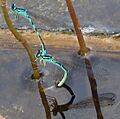List of Canadian damselflies facts for kids
Damselflies are amazing insects that look a lot like tiny, colorful helicopters! They belong to a group called Odonata, which also includes their bigger cousins, the dragonflies. Damselflies are found all over the world, and Canada is home to many different kinds.
You can often spot damselflies flying gracefully near water, like ponds, lakes, and slow-moving rivers. They have long, slender bodies and two pairs of wings that are usually clear. When they rest, most damselflies hold their wings together over their back, which is a good way to tell them apart from dragonflies, who usually hold their wings out flat.
Contents
What Makes Damselflies Special?
Damselflies are fascinating creatures with unique features. They have large eyes that help them see all around, making them excellent hunters. Their long legs are covered in tiny spines, which act like a basket to catch smaller insects while they fly.
Life Cycle of a Damselfly
Damselflies start their lives in the water. A female damselfly lays her eggs on plants in or near the water. When the eggs hatch, tiny nymphs (also called larvae) emerge. These nymphs live underwater, breathing through gills and eating small aquatic creatures.
Nymphs can live underwater for months or even years, shedding their skin as they grow. When they are ready to become adults, they crawl out of the water onto a plant stem or rock. Their skin then splits open, and the adult damselfly emerges, ready to fly and find a mate.
Damselflies as Hunters
Adult damselflies are skilled predators. They fly around catching small insects like mosquitoes, gnats, and flies right out of the air. This makes them helpful to humans by controlling insect populations. Their quick movements and sharp eyesight make them very good at hunting.
Types of Damselflies in Canada
Canada has many different families and species of damselflies. Here are some of the main groups you might find:
Broad-winged Damsels (Family Calopterygidae)
These damselflies are often quite beautiful, with broad wings that can be clear or have dark patches. They tend to fly near streams and rivers.
- Jewelwings: These include species like the river jewelwing and the ebony jewelwing. The ebony jewelwing has striking dark wings.
- Rubyspots: The American rubyspot is one example, known for its bright red spots on its wings.
Spreadwings (Family Lestidae)
Spreadwings are named because they often hold their wings partly open when they are resting, not completely folded over their back.
- Great Spreadwing: The great spreadwing is one of the larger damselflies you might see.
- Other Spreadwings: This group includes many species like the southern spreadwing and the swamp spreadwing.
Pond Damsels (Family Coenagrionidae)
This is the largest family of damselflies, and they are very common around ponds and lakes. Many of them are small and brightly colored.
- Red Damsels: Like the western red damsel and eastern red damsel, these have reddish bodies.
- Dancers: Species like the powdered dancer and vivid dancer are known for their quick, darting flight.
- Bluets: This is a very large group with many species, often blue. Examples include the northern bluet, boreal bluet, and familiar bluet. You might see them in large groups near water.
- Forktails: These are usually small and slender, like the eastern forktail and Pacific forktail.
- Sprites: Tiny damselflies often found in marshy areas, such as the sedge sprite.
Images for kids
-
Ebony jewelwing (Calopteryx maculata)
-
Powdered dancer (Argia moesta)
-
Tule bluet (Enallagma carunculatum)
See also









